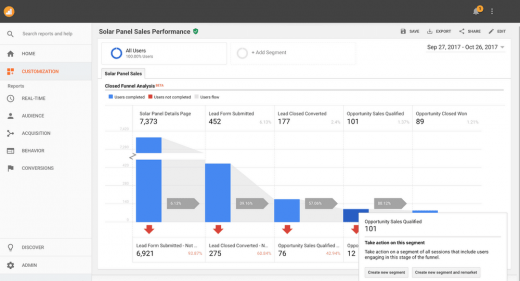Google Analytics 360: The Features Worth $150k a Year
— December 19, 2018
For many, Google Analytics 360 is a black box. Marketing and sales collateral from Google is spartan, and common refrains about key features—like unsampled data—seem unworthy of a six-figure bill for most sites.
That disconnect exists because many, myself included, have understood Google Analytics 360 primarily as an expansion of the data caps we encounter with the free version. As it turns out, those caps represent a fraction of overall value—like differentiating a presidential suite from a standard room based on square footage.
Charles Farina of Analytics Pros, who has used Google Analytics 360 for years, gave me an hour-long walkthrough of the platform to highlight the most meaningful differences: those that drive ROI.
Google Analytics 360 overview
Google Analytics 360 (GA360) is one of seven components of the Google Marketing Platform. With paid access to GA360—$ 150,000 per year, billed monthly at $ 12,500 with an annual contract—users also get access to 360 versions of other products:
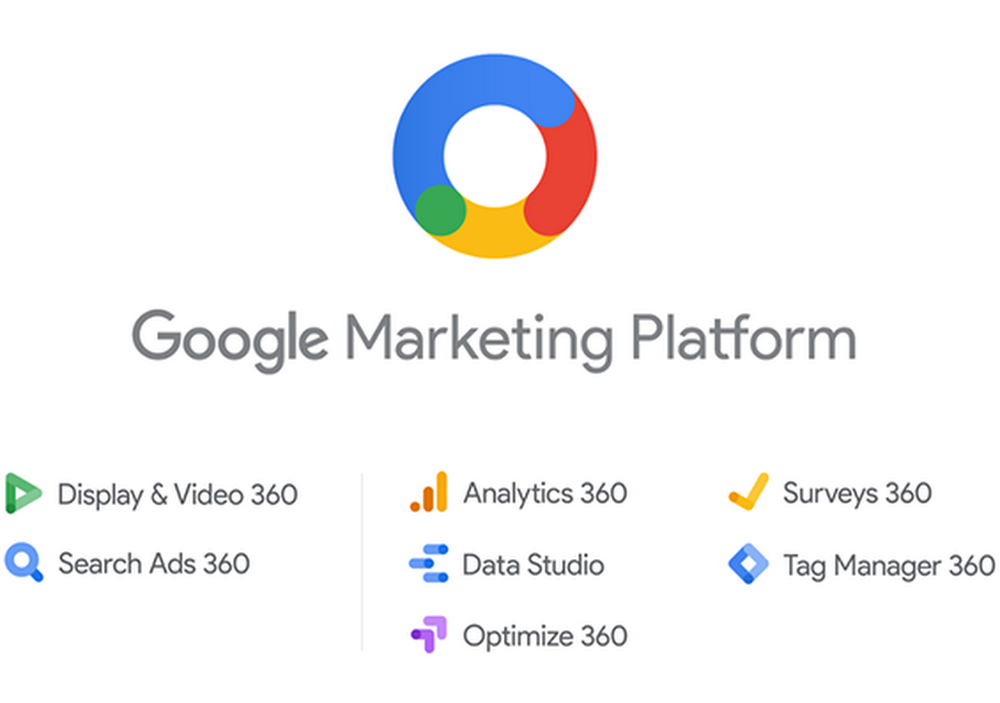
The announcement of the Google Marketing Platform, in June 2018, combined paid ad platforms and the Google Analytics 360 Suite. (Image source)
The GA360 license is all-inclusive: There are no tiers or additional features to unlock. (Users get credits toward BigQuery; extensive querying of GA data in BigQuery could generate added costs.)
Some differences in functionality between 360 versions and their free counterparts are limited. Tag Manager 360, for example, touts “enterprise level support” as the primary benefit.
This post focuses on Analytics 360 and the integrations with other platform products that occur within the Google Analytics UI.
Google Analytics 360 vs Google Analytics
Dry lists of feature comparisons are available in other posts, like this one from Blast Analytics or this one from Google. I won’t replicate those resources here, but a few oft-cited, quantitative differences are worth mentioning:
- Sampling. The free version of GA begins sampling data for non-default reports that exceed 500,000 sessions. GA360 doesn’t begin sampling data until reports exceed 100 million sessions. The free version also stops recording data at 10 million hits per month compared to 2 billion for GA360.
- Time lag. GA360 pushes all data into its reporting interface within four hours and often does so in a matter of minutes. That near-real-time data entry is faster than the free version, which usually takes a full day to process data.
- Export size. GA360 allows 3 million rows; the free version offers 50,000.
- Custom dimensions and metrics. GA360 offers 200 of each compared to the free version, which provides 20.
And yet, most businesses are not another custom dimension (or 50) away from actionable data; few make different decisions because their data is based on 87% of all sessions. (As Farina noted, “if you have 50% sampling, it’s still very likely that the data is directional.”)
Other well-known differences focus less on raw numbers and more on enterprise business needs:
- Roll-up reporting. GA360 allows users to roll up reporting from multiple properties efficiently with capabilities not available in the free version—deduplicating users, stitching sessions, inheriting custom dimensions and metrics, etc.
- Data-driven attribution modeling. GA360 moves beyond the standard attribution models available in the free version and—using machine learning—creates custom attribution models with data from GA and connected accounts, including TV ad buys.
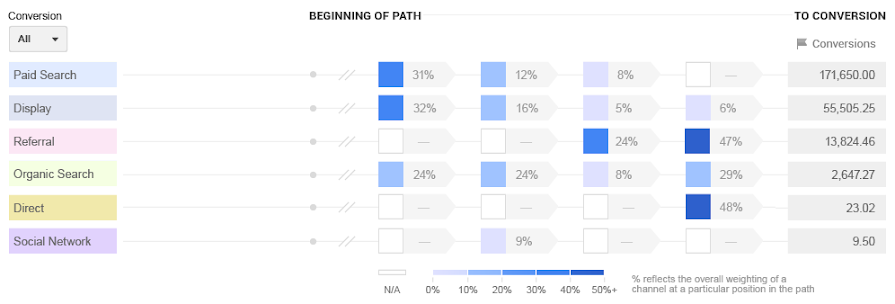
A report showing weighted attribution in Attribution 360, which allows users to create custom attribution models for GA data.
Each of the above features enables the collection of more data, improves the quality of data, or increases the accuracy of calculations from it. Still, those differences only hint at the bottom-line benefits of GA360, which center on:
- Connections between Google Analytics data and personally identifiable information.
- Integrations with a wider range of ad networks.
- Granular, actionable data visualizations.
Farina walked me through each.
The Google Analytics 360 benefits that generate ROI
1. Connections between Google Analytics data and personally identifiable information
In a previous agency job, I’d seen clients switch from Google Analytics to Adobe Analytics for one reason—to connect anonymous analytics data to specific users. Google Analytics has unambiguous warnings about collecting personally identifiable information (PII), which chases some to Adobe:

A platform change for that reason, it turns out, is unwarranted—if you take your GA data to the international waters of BigQuery.
BigQuery
BigQuery, part of the Google Cloud Platform, is a fully managed data warehouse. Integrating GA data with BigQuery is possible only with GA360. BigQuery starts with 13 months of historical GA data, collecting new data indefinitely moving forward.
“At the end of the day,” Farina explained, “if you can get data into BigQuery and you have a question you can write to that data, BigQuery will go out and answer that question without you having to worry about storage or compute or memory.”
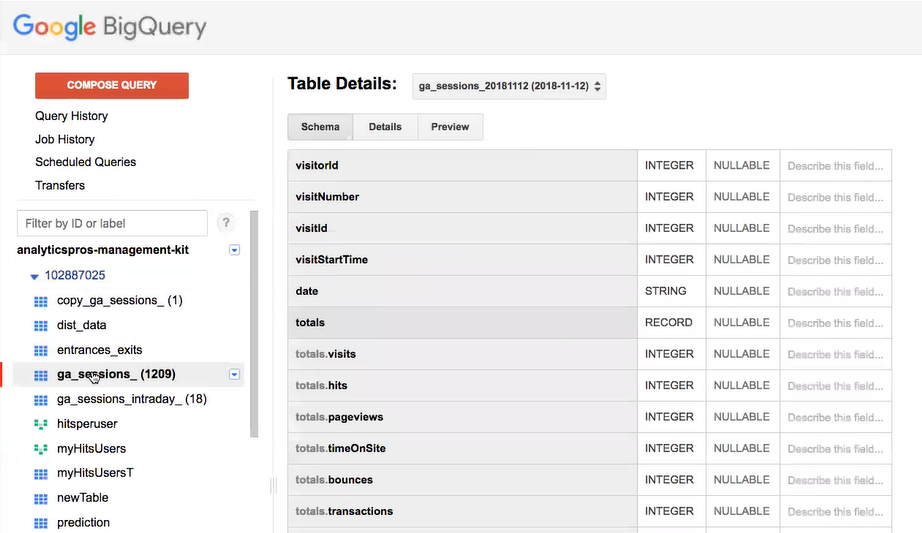
BigQuery bridges the gap between anonymous GA IDs and CRM data.
It is possible to export data from the free version of GA into another platform, but the process is incomplete and doesn’t scale: It relies on the GA API—a source of report data but not raw data—or a plugin, like the one for Google Sheets.
Because it has different Terms of Service, BigQuery can join GA data with PII—from your CRM or anything else you choose to connect. Once data is in BigQuery, SQL scripts return a user-by-user table with the requested data:
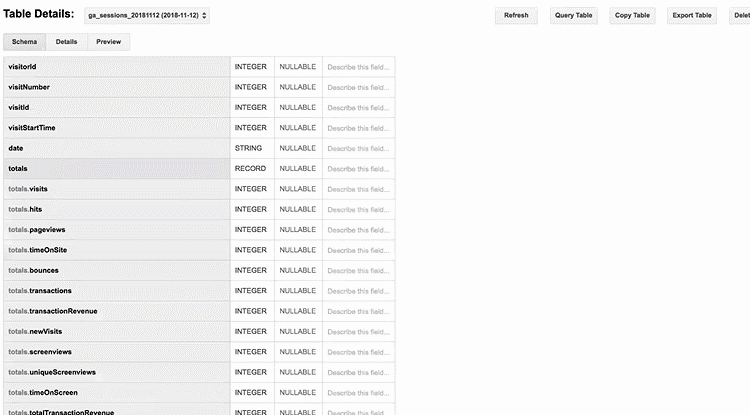
BigQuery can join data in GA to a CRM via, for example, a hidden field in a contact form that passes the anonymous GA ID into a field tied to an individual ID in a CRM.
As Farina detailed, some companies use BigQuery as their primary data warehouse; others treat BigQuery as a way station before passing data on (via export) to a preferred cloud storage system.
(BigQuery is HIPPA compliant, making it a viable repository for medical data or, consequently, any other type of personal data.)
GA360 and Salesforce integration
In 2017, Google announced a partnership with Salesforce; the two companies deepened that partnership in 2018. (Salesforce is now a reseller of GA360.) The collaboration yielded several integrations. Those with access to both products can:
- Move Salesforce data from Sales Cloud into GA360 for attribution reports, bid optimization, and audience creation.
- Push GA360 data into the Salesforce Marketing Cloud reporting UI.
- Connect GA360 audiences to Salesforce Marketing Cloud for inclusion in Salesforce campaigns (e.g. email, SMS).
- Create audience lists from customer interactions in the Salesforce Marketing Cloud.
- Import Salesforce Sales Cloud user attributes, Einstein Lead Scoring, and ecommerce metrics into GA360.
Those integrations enable the creation of funnels like the one below, which draws on data from both platforms:
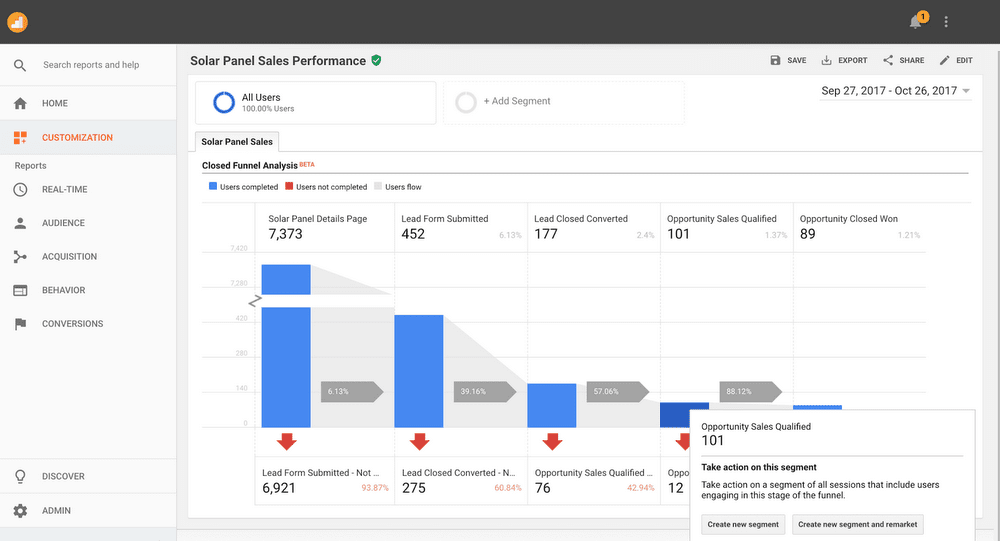
The Salesforce integration lets users create funnels with GA and Salesforce data. (Image source)
In another use case Farina suggested, companies could customize email content based on browsing behavior. If you manage a daily digest for The Seattle Times, for example, you could include more sports stories for sports junkies and more political headlines for partisans.
I asked Farina if the Salesforce integration was likely the first of many GA–CRM connections. But the Google–Salesforce partnership, Farina speculated, is unique: “Google doesn’t have a strong martech—no email tool, CRM, CMS; Salesforce doesn’t have enterprise analytics.”
The decision to integrate Salesforce with GA360, he continued, arose from the ongoing consolidation of martech stacks by Adobe: Adobe purchased Marketo in 2018, pressuring Google and Salesforce to offer a competitive alternative.
2. Integrations with a wider range of ad networks
Ad spend, rather than total traffic, may be the easiest way to justify a GA360 investment. If you’re currently spending $ 100,000 per month in Google Ads, Farina postulated, how much more efficient could you be with GA360? A 10% increase in efficiency would nearly cover the cost of GA360.
Not surprisingly, Google has case studies detailing strong improvements:
- Panasonic used GA360 to increase the return on advertising spend (ROAS) by 30%.
- Moncler’s GA360 investment delivered a 35% improvement to their ROAS.
The free version of Google Analytics already includes robust (yet underused) integrations with Google Ads. As Farina highlighted, you can build segments based on a combination of conditions, then export that audience to Google Ads for remarketing.
GA360 extends the capabilities available for Google Ads to other platforms and networks, like Campaign Manager, as well as non-Google networks, like Index Exchange, in Display & Video 360.
Display & Video 360
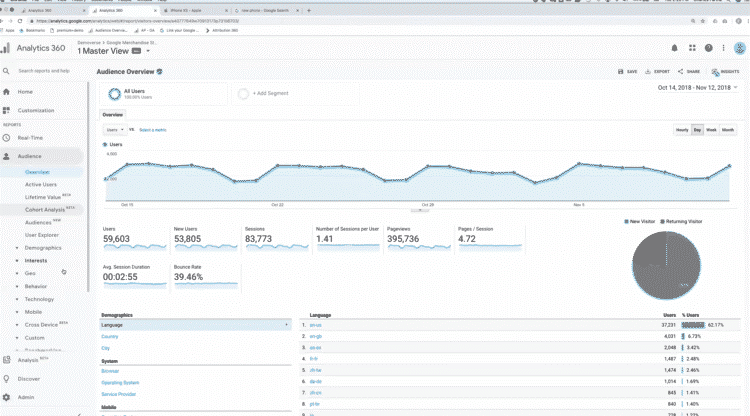
Display & Video 360 extends GA functionality for Google Ads to more ad networks.
Display & Video 360 pulls click- and view-through data from display and video ads into Google Analytics. The ability to include display view-throughs in Multi-Channel Funnels strengthens attribution models. In the example below, the eye icon represents display impressions:
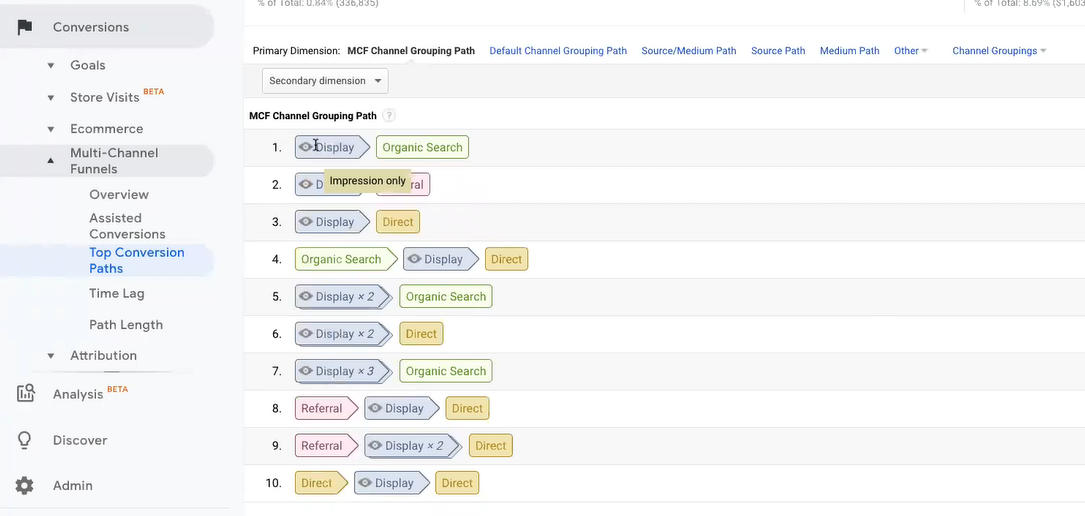
View-through data sheds light on potential catalysts for conversions from direct or organic sessions. Adding a secondary dimension, like Campaign, identifies instances when display impressions for a particular campaign were not the first brand interaction (and, therefore, deserve less credit in any attribution model):
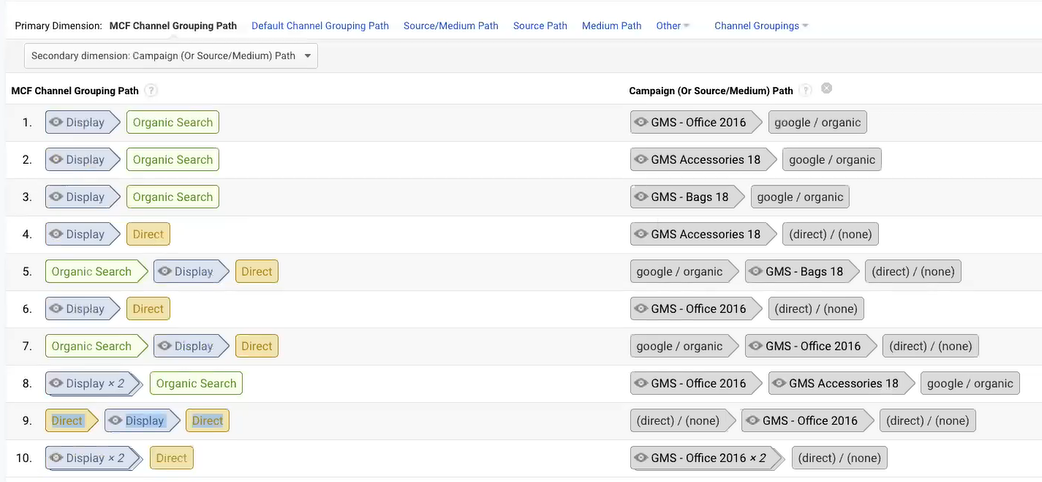
Because the data exists in BigQuery as well, audiences transition fluidly between anonymous Google Analytics users and known leads or customers in a CRM.
Thus, the value of GA360 is not merely getting more granular data on ad impressions but attaching that data to real users for smarter retargeting or tailored email campaigns.
3. Granular, actionable data visualizations
Two high-value data visualizations are unique to GA360: Custom Funnels and Advanced Analysis.
Custom Funnels
Building a useful funnel in the free version of Google Analytics, Farina conceded, is nearly impossible. In GA360, it’s simple—agonizingly so for those who have labored through funnel creation or analysis in the standard version.
Farina demonstrated how GA360 translates any combination of variables into a funnel in seconds:
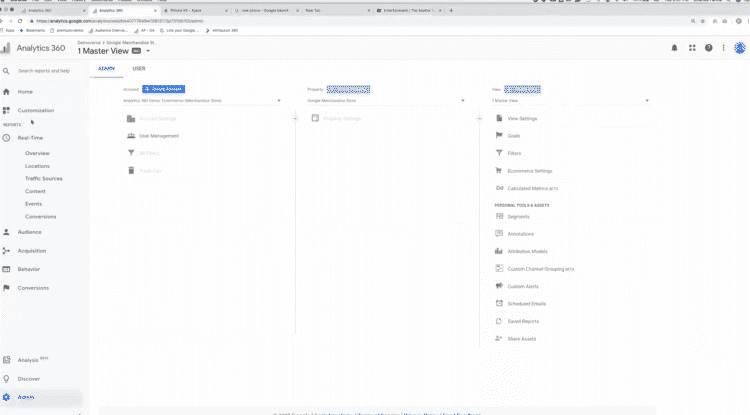
Custom Funnels are easy to create and simple to export as an audience or segment.
Like other GA360 features, the primary benefit of Custom Funnels is not only visualizing user behavior but translating that visualization into action through export to a marketing automation platform.
Advanced Analysis
Advanced Analysis, still in Google’s beta purgatory, “sits very closely between Data Studio and Analytics,” according to Farina.
Its drag-and-drop interface offers several report types, including a Segment Overlap that identifies users who share characteristics. That visualization, in turn, is available for export back into Analytics, where you can drill down from the audience level to the individual user:
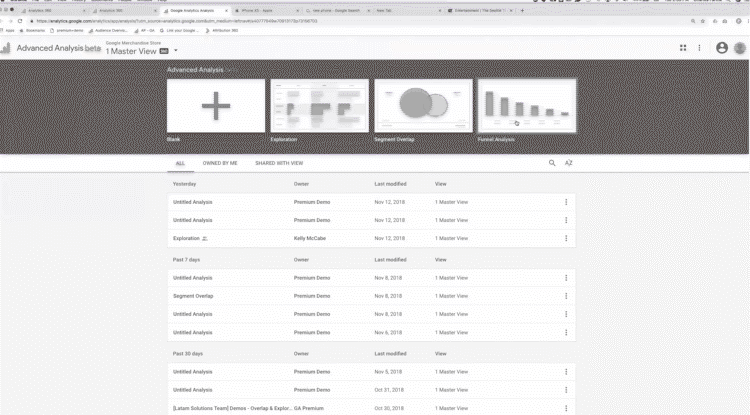
Advanced Analysis combines elegant visualization with granular user information.
Product-market fit and alternative solutions
A common refrain from Farina was that GA360 is an enterprise product—most users fail to max out the capabilities of the free version and wrongly assume that an unsampled report or limited export holds back analysis and growth.
Companies that are a good product-market fit for GA360 likely fall into one of three categories:
- Extremely high-traffic sites. According to Quantcast, about 600 U.S. sites generate more than 1 million monthly visitors—enough so that a month’s worth of data is sampled below the 50% threshold. For those sites (and many with less traffic), an enterprise analytics tool is essential.
- Large B2B companies that already use Salesforce. The managed integration of Google Analytics and Salesforce data would likely cover the costs for any independent effort to bind analytics and CRM data.
- Companies with high ad spend. As noted earlier, a $ 100,000 monthly ad spend requires a 12.5% increase in efficiency to cover the cost of GA360.
What about alternative analytics platforms like Heap, Segment, or similar options? Where do they fit into the analytics conversation?
To Farina, they’re good options for “advanced businesses with small data sets that don’t have the ad spend, volume, or are not yet at a level where $ 12,500 per month is something that they can allocate.”
A potential challenge of a patchwork system, Farina continued, is aligning all teams on the same data:
Even if you use Heap, it’s likely that Google Analytics is still a primary tool that marketing uses, where Heap might be something that the data science team starts to use more.
And the challenge that we’ve seen again and again is that, at that point, you have two different data sets and two different implementations and two different sets of metrics and conversions.
That can be a real challenge, especially when the data is not directional between platforms, and you get into this area where no one trusts it, no one is using it, and you’re not getting value out of either side.
I asked Farina a final question: If Google is worried about competition from Adobe, why not just give away other 360 features for free? Or charge $ 100 per month?
Some aspects of Google Analytics 360 are a clear drain on server resources, but others, like the ability to connect GA data to a CRM, could quickly undermine a primary selling point for Adobe.
“There’s a user journey,” Farina argued. “We already have great solutions for mid-market. You can use something like Google Analytics and add Segment or Heap if you’re not at the level of being able to benefit from a Google Analytics 360 or Adobe.”
Conclusion
If you continually bump up against the data caps of the free version of Google Analytics, a switch to Google Analytics 360 may be necessary—even though the business case might remain murky. You’ll get more complete data, but how will you drive more revenue with it?
The key benefits of GA360, then, are about putting data to work:
- Using BigQuery to connect on-site behavior with individual users for targeting via marketing automation platforms.
- Exporting tailored audiences in Google Analytics back into ad platforms for smarter remarketing.
- Using integrated ad spend data to create more reliable attribution models that, in turn, dictate ad spend.
Ultimately, Farina’s reference to the “user journey” applies to more than the analytics platform. It also includes overall marketing maturity: Even user-specific data or actionable attribution modeling will fail to deliver ROI unless those insights direct marketing efforts beyond analytics.
Digital & Social Articles on Business 2 Community
(48)

